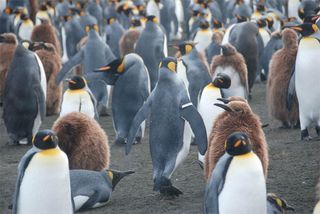In the Name of Science: Tracking Bands Can Harm Penguins

Penguins live at the bottom of the world, where scientists expect the most drastic global warming changes. As such, the waddling birds have become beacons of environmental change, so much so that they've been strapped with identification bands so climate scientists can monitor their whereabouts (and health status).
But the harm caused by this method of flipper tagging may outweigh the benefits, a new study suggests. Over a 10-year period, banded penguins produced 39 percent fewer chicks and had a survival rate that was 16 percent lower than birds without bands. [Image of penguins wearing flipper bands]
Yvon Le Maho, an ecologist at the University of Strasbourg and the French National Center for Scientific Research, and his collaborators reported the findings today (Jan. 12) in the journal Nature.
Tracking penguins
Le Maho and his team tracked 100 king penguins (Aptenodytes patagonicus) on an island in the southern Indian Ocean near Antarctica by implanting electronic tags under their skin. Half of these birds also had metal bands put on their flippers. [Image of flipper band]
The researchers found that banding increased mortality in less-fit birds during the first 4.5 years. The banded penguins also had less time and energy to reproduce and care for their young, because they spent more time foraging and arrived more than two weeks late to breeding areas.
"There was no sign the birds adapted to the handicap caused by the bands, even after 10 years," Le Maho said.
Sign up for the Live Science daily newsletter now
Get the world’s most fascinating discoveries delivered straight to your inbox.
Extra baggage
Rory Wilson, an ecologist at Swansea University who was not involved in the research, said the extra baggage likely increased the drag penguins experienced and impaired their athletic performance. Any hindrance makes a huge difference to the animals, because they swim so efficiently, Wilson said.
Wearing the equipment forces penguins to expend 24 percent more energy while swimming, an amount similar to humans running with a heavy backpack, Wilson said, referring to research he has done on captive Adelie penguins. What's more, the gear could injure the flippers and attract the attention of predators, he added.
"Although at any one moment for any one day, the impediment is perhaps not that great, if you put on a band for the animal's life, then it's carrying that cost every hour of every day, and that could come to be quite a serious cost," Wilson told LiveScience.
The effect the banding had on breeding success varied each year, depending on climate patterns, the research team found. Banded birds suffered more than nonbanded birds during normal years, but the two groups fared similarly when environmental conditions were extremely favorable or very poor. Le Maho said that it’s necessary to monitor animals for a long period to fully appreciate the impact of banding.
Future of banding penguins
Because the approach diminishes survival and reproduction, Le Maho warned that climate change studies relying on banded birds are biased and produce questionable results.
Meanwhile, thousands of penguins still carry bands, and because they’re cheap, durable and convenient, scientists may continue to use them in the future.
"The big question for scientists using flipper bands is how much and under what conditions is banding penguins justified," Wilson said. "I would say that if anyone puts bands on, there has to be a bloody good reason for it."
Wilson said that the repercussions of banding would "absolutely" carry over to other penguin species, and possibly even seals and sea turtles. Scientists have also investigated the impact of climate patterns on Emperor penguins (Aptenodytes forsteri), Adelie penguins (Pygoscelis adeliae) and Galapagos penguins (Spheniscus mendiculus), among others.
- Album: Life at the South Pole
- Flightless Birds: All 18 Penguin Species
- North vs. South Poles: 10 Wild Differences
You can follow LiveScience on Twitter @livescience.
